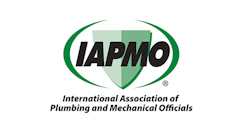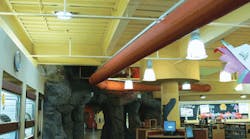HIGHLAND, CALIF. — Librarians typically don’t pay much attention to HVAC systems, however the fabric air dispersion system specified for the $15 million, 30,000-sq.ft. Highland Sam J. Racadio Library and Environmental Learning Center here, along with a water-source heat pump loop, PV system and other methodologies instrumental in the LEED Gold certification, caught the eye and ear of Jessica Sutorus, branch manager.
To comply with the noise standards, all heat pumps and other equipment were installed with spring-type vibration and isolation mounts by Mason Industries, Hauppauge, N.Y., and fabric duct was installed because of its quiet nature.
While there are noise and performance advantages to fabric air dispersion, Farzad Tadayon, P.E., LEED AP and president of T-Squared Professional Engineers Inc., Vista, Calif., said the aesthetic upgrade versus spiral metal duct became evident during the design stages.
Fabric duct is characteristically quieter because the air is distributed through dozens of orifices spanning the length of a run versus just a few registers as with metal duct systems, which tend to promote turbulence and subsequently high levels of air noise, according to Tadayon, and furthermore, the softness of fabric duct doesn't reverberate noise from mechanical equipment housed in other building areas.
Related Articles:
Library gets a lift from Shaw Mechanical
"There’s a big difference in noise between the fabric duct throughout the building and a conference room, the only room using metal duct,” said Sutorus, who worked with engineers and architects to achieve the most cost-efficient LEED benefits. “We also liked the ability to customize the fabric’s color to complement the interior design.”
Sutorus, who suffers from allergies, claims the new building has reduced allergy symptoms for her and other staff members. The more than 1,000 linear feet of DuctSox's Sedona-Xm model fabric averages 16-in. diameters and uses a built-in anti-microbial agent that resists bacteria harboring.
While fabric duct contributed to the project's LEED credits, it was one of the few alternative products that also contributed to value engineering.
"Using fabric versus metal duct saved the project around 20% in labor, which required only two workers to install the suspension system and one worker to connect the fabric duct to the hangers," said Glen Roberts, construction manager of the project's mechanical contractor West-Tech Mechanical Inc., Montclair, Calif.
Indoor air quality was also a consideration because the thousands of books stocked in a library environment, not to mention carpeting, paint, coatings and other building materials, generate significant levels of off-gassing. To continually remove volatile organic compounds, Tadayon's IAQ design included 30% more outdoor air than what ASHRAE 62.1 standards recommend, but with little effect on his energy-saving strategies.
Custom fabricating the duct
Tadayon found it easy to design the radiuses needed to follow the many asymmetrical contours and radiuses of walls that the architect incorporated into the interior architectural design.
Manufacturer's representative, Toro Aire, Dominguez Hills, Calif., was instrumental in helping facilitate the many radiuses needed for DuctSox's factory engineers of Peosta, Iowa, to custom fabricate the duct and the aluminum H-Track hanging system to follow the interior design's many contours.
Both the engineer's design and the fabric duct fabrication helped make a smooth and glitch-free installation of the project's dozens of fabric duct and H-track suspension radiuses, according to Roberts, and particularly difficult were transitions from the standard 10-ft. ceilings to vaulted ceilings, the latter which needed the H-track hung with cable 10-ft. high to keep the fabric runs parallel with the floor.
"Our company had used fabric duct in industrial projects before, so we were surprised to see the industry's recent advancements and materials upgrades," said Tadayon. "We all agreed shaping the ductwork around all the building's contours wouldn't have been as visually effective with metal duct for the facility's overall interior design."
Energy-efficient systems
The building design surpassed the 2001 California Energy Efficiency Standards for Non-Residential Buildings by 40% and features 30 high-efficiency heat pumps ranging from 12.1 to 13.9 SEER from the Axiom Series by Trane. Also specified was one Recold, Brea, Calif., fluid cooler with an extra loop within the unit for better heat transfer and improved efficiency, and a 750 Mbh high-efficiency boiler by Fulton Boilers, which provides hot water to the loop.
"We looked at high-efficiency packaged rooftop units, chilled water systems and other methods, but a water-source heat pump loop was the best design in terms of lifecycle and operational costs," said Tadayon.
Other energy saving specifications were Trane variable frequency drives (VFD) for two 10-hp circulating pumps by the Weinman division of Crane Pumps & Systems; a photovoltaic system, which provides the library with 5% of the facility's electric needs, installed by Borrego Solar Systems, Berkeley, Calif.; and a direct digital control system, which provides optimal energy use for both the HVAC and lighting systems.
Additionally, the library’s cooling towers have chemical-free water treatments with water sanitation equipment from Dolphin WaterCare div. of Clearwater Systems LLC, Essex, Conn. This feature reduces air and water pollution while improving energy efficiency and eliminating potential operational hazards from handling chemicals.
When asked why it was important for the library to be built with conservation goals in mind, Joseph Hughes, city manager of the City of Highland, said, “We wanted to show the community what can be done to ease the impact on the environment while still providing an exciting facility that people will want to come to, to be educated. The building itself is a learning tool on constructing a building, using state of the art conservation practices.
“It is exciting to have such a unique building in our community,” continued Hughes. “Working closely with the County of San Bernardino, who staffs the facility, was a very important part of the process to bring this facility to fruition. Having the ability to bring in children from the community to learn about recycling, the ecosystem and other environmental issues while still having a fully functioning library is an exciting part of the project.”
The LEED Gold building may serve as a green role model for future library projects according to Sutorus. Several American Library Association members and officials have visited the facility to review its successes.



